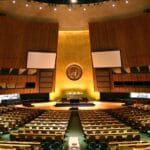Revisiting radioactive source security
By Fissile Materials Working Group | November 2, 2012
The possibility of radioactive material falling into the hands of criminal organizations or terrorists remains a real and persistent security threat. The International Atomic Energy Agency (IAEA) reports that, since 1993, there have been more than 2,000 confirmed incidents of lost regulatory control over potentially dangerous material, including nearly 150 incidents last year. Given the unsettling frequency of reported cases, it may seem surprising that there is no legally binding international convention pertaining to the safety and security of radioactive sources that requires states to take preventive action. However, imposing binding commitments on states to enact stronger regulatory controls — though potentially useful to some degree — is not a silver bullet for what will remain a very large and multifaceted security challenge.
Radiological security is commonly associated with the threat of terrorists detonating a “dirty bomb” — a dispersal device consisting of conventional explosives laced with radioactive material — as a way of using people’s natural fear of radiation to create chaos that is disproportionate to the actual health risk. However, it is important to remember that there are numerous other ways in which radioactive material could be used to wreak havoc: It could be a surreptitiously placed radiation-emitting device or — as James Acton, Brooke Rogers, and Peter Zimmerman point out in the journal Survival — used in an attack that causes people to inhale, ingest, or immerse themselves in a radioactive substance. The dirty bomb scare is only the tip of the iceberg with respect to radiological threats.
Moreover, because these materials are widely used in medicine, industry, and agriculture, there are literally millions of potential sources of radioactive material around the world. Also, small-but-significant amounts of radioactive material remain in thousands of orphaned containers outside regulatory control. Yet all of these radiological materials originate from a relative few supplying countries — Argentina, Belgium, Canada, France, the Netherlands, Russia, South Africa, and the United States — that produce and export them. Therefore, a top-down approach to security focused primarily on regulatory controls at the state level does have some intuitive appeal.
The IAEA’s Code of Conduct on the Safety and Security of Radioactive Sources and its supplementary Guidance on the Import and Exports of Radioactive Sources arguably serve as embodiments of such an approach. The Code of Conduct, first published in 2004, is the result of a consultative process launched in the 1990s and, following the recommendation of participating technical experts, is non-binding in nature. It recommends that states inspect facilities, ensure safety and security during use and disposal of sources, monitor inventories, track high-risk materials, strengthen export controls, and require licenses for radioactive-material users from a regulatory authority. To date, more than 100 countries have written to the IAEA to officially and enthusiastically register their support for the Code of Conduct and its aims.
Such widespread support for the Code of Conduct and implementation of other regulatory controls is certainly encouraging, but it raises an important question: Why is there still so much illicit trafficking and unauthorized use of radioactive materials? The short answer is that there are multiple causes — from lax security in some instances to relatively mundane protocol mistakes in others.
These vulnerabilities are not confined to small countries that are acutely resource-constrained or that lack appreciation of the danger. Indeed, the US Government Accountability Office’s recent report on the security of radiological sources at US medical facilities is instructive. The report, which examined security practices and protocols at 26 hospitals and medical facilities around the United States, found that only a small fraction of locations identified as high-risk were receiving security upgrades through the National Nuclear Security Administration’s Domestic Material Protection Program and that several high-risk locations had, in fact, declined to participate due to cost concerns. At other locations, the Government Accountability Office found several disheartening security lapses — such as a lack of awareness as to which personnel had access to radiological sources, confusion among some security inspectors about how to interpret and implement regulations, and even codes to doors protecting radioactive material clearly written on the door’s frame.
The findings starkly illustrate that a top-down approach is far from enough; countries also need to pursue bottom-up approaches that improve capacity and competence on both the institutional and individual levels. Furthermore, these findings underscore the importance of cultivating a robust and sustainable security culture wherever radioactive materials are stored, used, and disposed. As Igor Khripunov persuasively argues, it is important to develop specific sub-models that apply specifically to the different contexts in which radioactive material is used and to the individuals responsible for its safekeeping.
However, whether at US medical facilities or at the other many places where radioactive material is transported, used, and disposed, the reality is that perfect security is unachievable. There will always be a potential for mistakes, mischief, and other security lapses that cannot simply be regulated away from the top or completely removed by a well-functioning security culture. Therefore, to reduce risk, it is important to pursue a layered approach to minimize both the probability of a radiological attack and the potential consequences if such an attack is carried out.
To that end, it is useful to think in terms of a “defense-in-depth” — or layered approach — to radiological security. Defense-in-depth includes efforts aimed at decreasing the availability of radioactive materials by tracking down and securing orphan sources, improving export controls and national regulations, opening up pathways for the safe disposal of material by allaying public fears about radioactive waste, and decreasing the use of the more dangerous radioactive materials — like cesium-137 and cobalt-60 — by developing economically viable alternatives. This approach also includes efforts to stop and mitigate the effects of radiological terrorism by deploying radiation detectors, improving capacity and training for first-responders, and investing in nuclear forensics research and related data-collection efforts so that the material used in any radiological attack can be traced back to its origin. Finally, it may be useful for the IAEA to lead an effort to identify the most important foundational elements of radiological security and then to revisit the issue of giving them expression in a legally binding convention. This effort will undoubtedly take years, but, if smartly constructed, could incentivize states to do more while improving the quality and consistency of legal and regulatory frameworks internationally.
With states still struggling to secure potentially dangerous materials and with a dirty bomb being but one of dozens of ways radioactive material could be used in a terrorist attack, relying on just one manner of security is nothing if not shortsighted.
Editor’s note: This column was written by Fissile Materials Working Group members Mark Jansson, the special projects director at the Federation of American Scientists, and Charles D. Ferguson, the president of the Federation of American Scientists.
Together, we make the world safer.
The Bulletin elevates expert voices above the noise. But as an independent nonprofit organization, our operations depend on the support of readers like you. Help us continue to deliver quality journalism that holds leaders accountable. Your support of our work at any level is important. In return, we promise our coverage will be understandable, influential, vigilant, solution-oriented, and fair-minded. Together we can make a difference.
Topics: Columnists, Nuclear Weapons















